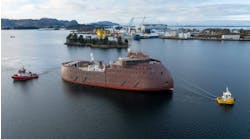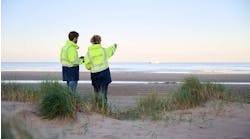Editor's note: This story first appeared in the September-October 2022 issue of Offshore magazine's first annual Offshore Wind Special Report. Click here to view the full Offshore issue or click here to view the special report.
By Laura Morton, Aubri Margason and Kerensa Gimre, Perkins Coie
The US administration’s goal of generating 30 GW of power through offshore wind by 2030 has spotlighted the Bureau of Ocean Energy Management (BOEM) to rapidly ramp up offshore wind development. BOEM’s ambitious leasing agenda between now and 2025 reflects this pressure, with a record-breaking sale of six leases in the New York Bight for $4.37 billion in February 2022, two lease sales in North Carolina, a California auction planned for fall 2022, and progress on leasing for the Gulf of Mexico, Central Atlantic and Oregon, with the Gulf of Maine to follow.
In addition to approving two commercial-scale projects, BOEM is actively processing 11 construction and operations plans (COPs) and expects to receive seven or more additional COPs by February 2023, has or plans to initiate eight environmental impact statements (EISs) in 2022, and plans to issue nine final EISs in 2023.
BOEM also is developing guidance on mitigating potential offshore wind impacts to fisheries and anticipates publication this year of the long-awaited notice of proposed rulemaking on renewable energy modernization.
Given such high deployment expectations, BOEM is facing significant headwinds to deliver projects on time. Permitting schedules for projects under review are already starting to slip—the release date for the Empire Wind Draft EIS has moved from August to November 2022, and other Atlantic Coast projects are also reporting delays. To address this challenge, BOEM has sought more funding and staff in its fiscal-year 2023 budget request and is assessing mechanisms to maximize what it can accomplish in a short period of time, including its June publication of standard screening criteria for alternatives to be analyzed in detail in future COP EISs.
One major shift in BOEM’s permitting strategy is considering a regional approach to evaluating the environmental impact of multiple projects, with the first step being the initiation of a programmatic environmental impact statement (PEIS) for the New York Bight lease areas. A PEIS allows an agency to assess direct, indirect and cumulative environmental impacts of common issues across multiple proposed actions. Subsequent National Environmental Policy Act documents can then be tiered off the PEIS to avoid duplicative analyses.
The New York Bight PEIS, indicated by BOEM to be published in advance of the lessees’ COPs, will allow BOEM to conduct
- An analysis of a representative project’s expected impacts and analysis of programmatic avoidance, minimization, mitigation and monitoring (AMMM) measures; and
- A focused, regional cumulative analysis.
BOEM will also identify minor or negligible impacts so that site-specific review can focus on moderate/major impacts and determine how to tier project-specific analyses. BOEM intends to use the PEIS to adopt programmatic AMMM measures that it can require as conditions for project-specific COP approvals.
In theory, the PEIS would create BOEM process efficiencies, streamline the environmental review process and provide increased transparency and predictability for lessees moving toward COP completion. A PEIS could also incentivize developers to collaborate on mutual mitigation measures. Developers will share an interest in ensuring that the PEIS reflects the best available information about their lease areas and may therefore be motivated to share information with BOEM and among themselves. This could lead to an upfront agreement between developers on mitigation measures for common concerns, such as North Atlantic right whale protection, rather than project-by-project solutions.
BOEM may want to consider making at least some of the AMMM measures in the PEIS advisory or subject to modification. As developers obtain more survey data and research on protected species leading up to COP submittal, they may be able to present more efficient, effective or innovative means of mitigating potential impacts than BOEM envisioned at the PEIS stage. Therefore, adaptive management principles become important components of any mitigation measures imposed by BOEM, in a PEIS or subsequent COP.
To further increase the New York Bight’s PEIS efficiency, BOEM has opted to use a project design envelope (PDE) to analyze environmental impacts, following the approach of the UK and other European countries. This approach minimizes the need for subsequent environmental and technical reviews at the project stage, as the PDE defines, brackets and analyzes the reasonably foreseeable characteristics of the six New York Bight COPs while maintaining a degree of flexibility for individual project component selection.
Developers can choose to submit projects that fit into an approved envelope of design parameters, but if the developer’s final design is outside the approved range, then further environmental review may be required. BOEM has not yet wholly embraced the full flexibility the PDE approach offers and should consider additional methods of granting flexibility, for example, through granting PDE-based departures from survey regulatory requirements. BOEM must closely consult with the industry to ensure it analyzes a reasonable set of parameters, given the strong possibility that leaseholders may use different wind turbine technologies and may be developing their project designs at different paces.
Unfortunately, the PEIS approach may not be easily transferrable to other planned lease areas—something BOEM has acknowledged during public scoping meetings for the New York Bight PEIS. The New York Bight is unique in the number of lease sales, proximity of the lease areas, uniformity of the species and benthic and seafloor environment, and expectations of how quickly COPs are to be submitted. On the latter point, BOEM has noted that a PEIS could be too outdated if COPs are expected over a longer period (e.g., five to six years). Offshore wind technology also is evolving rapidly, making it critical that the PEIS process allows sufficient flexibility to consider the potential for significant innovation, which is essential to maximize the clean energy produced per lease acre.
At minimum, the New York Bight PEIS process will be a learning experience for both BOEM and developers and will at least pave the way for BOEM to evaluate other creative options for streamlining environmental analyses in future lease areas. For example, BOEM plans to work with the National Marine Fisheries Service and the US Fish and Wildlife Service to develop programmatic approaches and templates for Endangered Species Act compliance and Essential Fish Habitat assessments for the entire New England and Mid-Atlantic regions. BOEM also expects to apply this programmatic consultation approach in the New York Bight.
Given the Save Long Beach Island litigation over the designation of wind energy areas in the New York Bight and the challenges to BOEM’s decision to approve the Vineyard Wind project, there is no reason to believe that the New York Bight PEIS would be immune to litigation. BOEM should consider whether a lawsuit challenging the PEIS or individual projects based on tiering to the PEIS would delay projects that already have COPs underway.
The pace and volume of tasks before BOEM is significant. Although its efforts to achieve efficiency gains through using a PEIS is encouraging, only time will tell whether BOEM maximizes these potential gains, for example, through embracing the full flexibility of the PDE approach or choosing to make some AMMM measures advisory or modifiable. Looking beyond the New York Bight, BOEM may be forced to find new ways to increase the efficiency of its environmental reviews. As BOEM tackles new challenges and the enormity of the tasks before it, litigation may also slow the process and frustrate goals to achieve ambitious timelines.
About the authors:
Laura Morton (partner), Aubri Margason (associate) and Kerensa Gimre (associate) are with Perkins Coie’s Environment & Natural Resources practice group. Laura Morton has more than 20 years of high-level government and private practice experience on major offshore wind projects development. She advises at all stages of these complex projects, including environmental review and permitting required for generation, transmission and related infrastructure.
Aubri Margason helps clients navigate and resolve regulatory compliance challenges associated with product and project development, launch and operation.
Kerensa Gimre works with clients on a range of federal, state and local regulatory topics, including the National Environmental Policy Act, Clean Water Act, National Historic Preservation Act, Marine Mammal Protection Act and the Endangered Species Act.



